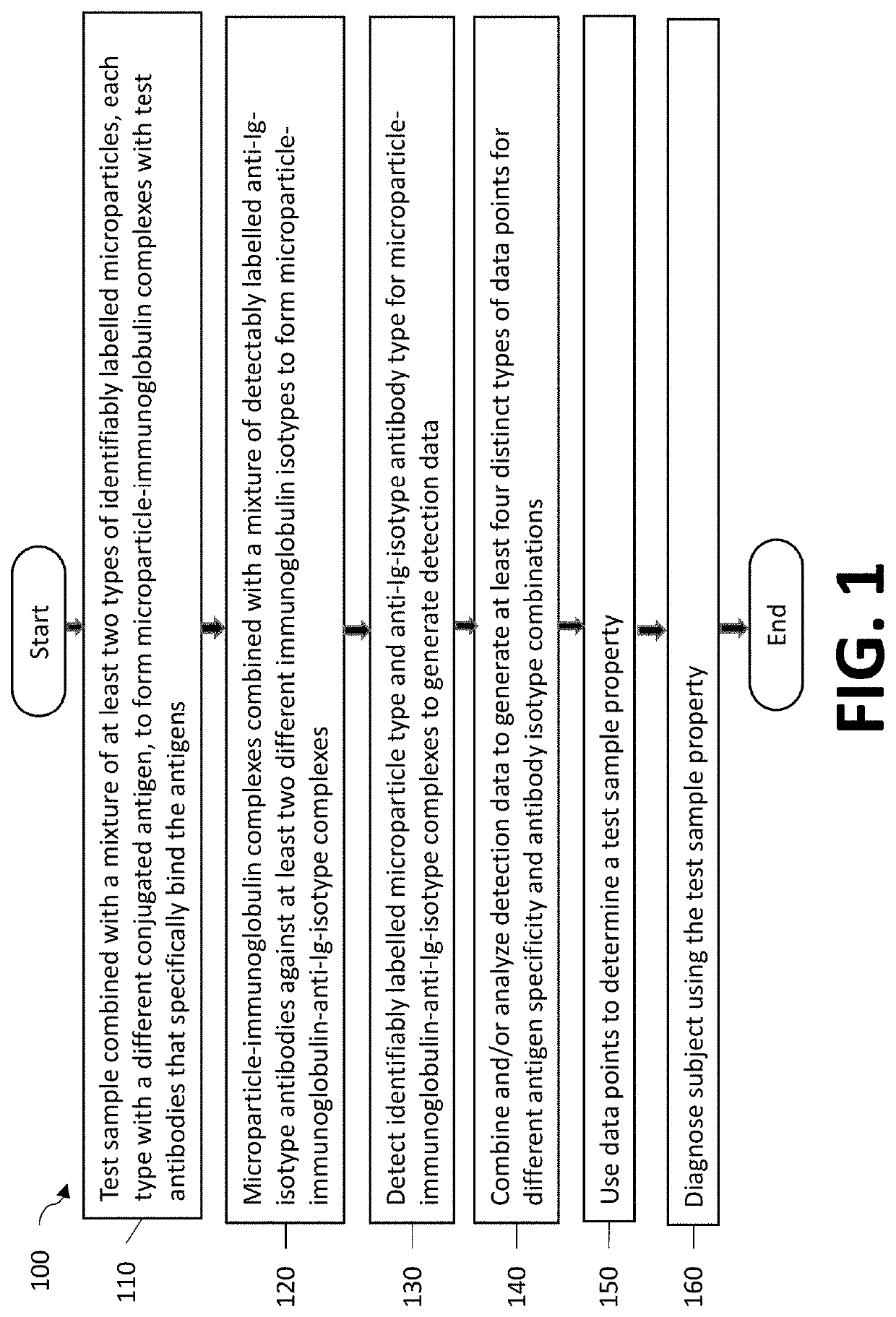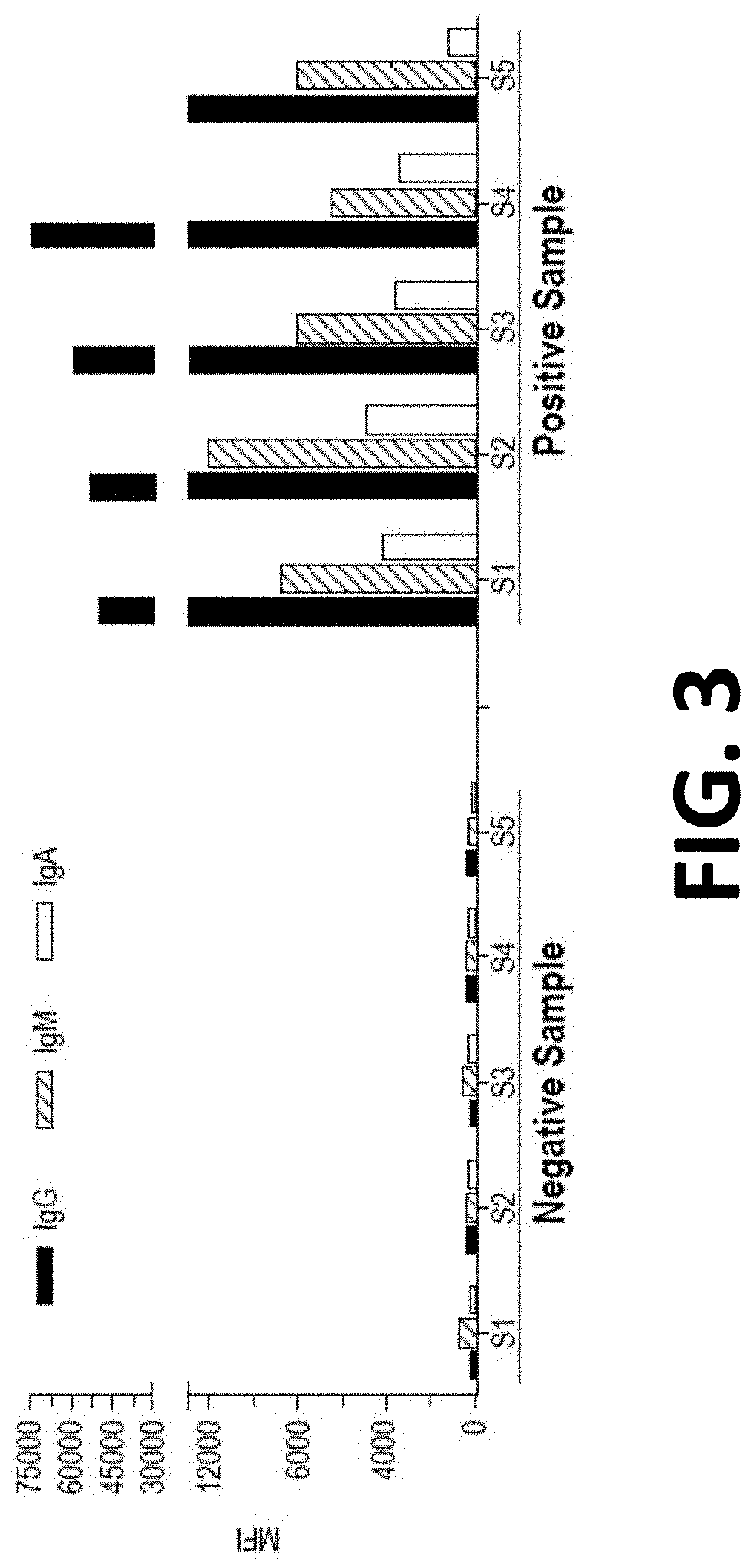Double-multiplex assay for multiple immunoglobulin isotypes
- Summary
- Abstract
- Description
- Claims
- Application Information
AI Technical Summary
Benefits of technology
Problems solved by technology
Method used
Image
Examples
example 1
Simultaneous Detection of Multiple Immunoglobulin Isotypes Against a Single Antigen
[0150]Single antigen-conjugated microspheres with a fluorescent signature, in which the antigen was RBD, were incubated with a test sample, allowing the immunoglobulins present in the sample to bind to the antigen on the surface of the microspheres. Test samples were plasma samples from SARS-CoV-2 patients (n=5, positive status confirmed by RT-PCR) or negative control patients n=5, samples collected 2 years prior to emergence of SARS-CoV-2).
[0151]After washes, the microspheres were sequentially incubated with anti-Ig-isotype antibodies with different fluorochromes, forming microparticle-immunoglobulin-anti-Ig-isotype complexes. After further washes, the microspheres were acquired on a multi-color flow cytometer. Appropriate flow cytometers include a FACSLyric™ or FACSCanto II™ Flow Cytometry System (Becton Dickinson, N.J.). Here a FACSCanto II was used. Values were measured as MFI ranging from 0 to 75...
example 2
Double-Multiplex Assay for SARS-COV-2 Exposure
[0154]Subsequent to exposure of a subject to SARS-COV-2, anti-SARS-CoV-2 antibodies may appear in the blood as a result of an immune response. Usually IgM antibodies can be detected 5-10 day after exposure or symptom onset while IgG and IgA can be detected several days later.
[0155]Double-multiplex assays as described herein can simultaneously detect the presence of three antibody isotypes (IgM, IgG and IgA) against three different SARS-CoV-2 antigens (RBD, S1, and NP) in the same well using a single test. Results are measured by a flow cytometer and presented in median fluorescence intensity (MFI, ranging from 0-262,144 MFI) data points for each antibody isotype and antigen combination.
[0156]All peripheral blood samples were collected at Stanford University using venipuncture. Seventy-nine negative samples were collected 2 years prior to the COVID-19 pandemic and 30 positive samples were collected from patients referred for testing after...
example 3
Comparative Analysis: Specificity and Sensitivity of Double-Multiplex Technology Compared with ELISA
[0250]ELISA is a plate-based technique commonly used to detect and quantify antiviral antibodies. The method utilizes viral protein antigens coated on plastic microtiter plates to capture antiviral antibodies in a sample, which may be derived from a number of bodily fluids, including blood, serum, and sputum, among others. The sample is left in contact with the coated antigen to allow relevant antibodies to bind, after which the plate is washed several times. Captured antibodies are detected by secondary species-specific antibodies complexed with a reporter enzyme that, when provided with the appropriate substrate, produces a measurable output.
[0251]The sensitivity and specificity of the double-multiplex assay of Example 2 was compared with that of an ELISA.
[0252]Ig isotypes (IgG, IgM, and IgA) against two SARS-CoV-2 antigens, RBD, and NP, were detected using a conventional ELISA form...
PUM
 Login to View More
Login to View More Abstract
Description
Claims
Application Information
 Login to View More
Login to View More - R&D
- Intellectual Property
- Life Sciences
- Materials
- Tech Scout
- Unparalleled Data Quality
- Higher Quality Content
- 60% Fewer Hallucinations
Browse by: Latest US Patents, China's latest patents, Technical Efficacy Thesaurus, Application Domain, Technology Topic, Popular Technical Reports.
© 2025 PatSnap. All rights reserved.Legal|Privacy policy|Modern Slavery Act Transparency Statement|Sitemap|About US| Contact US: help@patsnap.com



